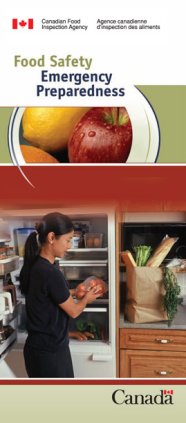Food >
Consumer Centre > Food Safety Tips Food Safety Emergency Preparedness/Power Failure
Be Prepared for Emergencies
Preparing yourself and your family for emergencies is a smart idea that could save
lives. Knowing safe food handling practices is an important part of emergency preparedness
that can prevent foodborne illnesses in the event of natural disasters, accidents or
intentional incidents.
Get to know the risks of natural occurrence in your area that could become emergencies,
such as winter storms and other winter hazards, tornadoes, earthquakes or landslides,
power outages, floods and large-scale accidents such as chemical spills. Unfortunately, no
country is immune to terrorism. Be aware of the dangers that could be presented by an
intentional act and listen to the guidance from official authorities.
Make a Plan and Prepare a Kit
Formulate an emergency plan for your household and prepare an emergency kit for your
home and your vehicle. Remember that in the event of a disaster or incident it may take
emergency workers up to three days to reach you. Proper food handling and preparation is
always important in preventing foodborne illness, yet food supplies may become
contaminated, damaged or spoiled in an emergency situation.
An emergency kit should contain a three-day supply of drinking water: four litres per
person, per day for drinking, cooking and cleaning. A three-day supply of non-perishable
food in hermetically sealed containers with proper equipment and utensils should also be
included in your emergency kit. Items that could be included in your kit, along with the
food, are can and bottle openers, dishes and utensils, disinfectant soap and bleach, a
portable cooking stove with adequate fuel, matches, leather gloves for handling hot
material and a folding saw or axe in the event there is firewood available for warmth and
cooking. |
 Printer-Friendly PDF
Version |
Food Safety Tips for Emergencies
In the event of a natural disaster or emergency incident, be sure to carefully inspect
all food items and do not eat any food you think may be unsafe. Remember, when in
doubt, throw it out. Check food in your refrigerators and freezers for signs of
spoilage, and ask retailers and restaurateurs to explain how food has been kept safe
during power failures. Be prepared with these food safety tips.
Be Aware of Bacteria and Hazardous Contamination
- Throw away fresh meat and produce and any food, including packaged food, that has been
contaminated by flood water, snow and ice, chemicals, animal waste, soil and dirt or
extraneous materials from the outside environment. Contamination can occur from these
circumstances if bacteria or other hazardous materials come in contact with food. Even if
the food appears to be dry it still may not be safe.
- Food in glass or plastic jars and bottles may be unsafe, as hazardous materials may seep
into the lids of these containers and may contaminate the food.
- Be aware that home canned foods in glass containers that have come in contact with
hazardous materials may also become contaminated and unsafe.
- Only food in hermetically sealed, airtight containers is safe, such as metal cans, juice
boxes and packages of freeze dried meals. However, these containers must be carefully
cleaned and disinfected before use. Containers that are bulging or damaged are considered
unsafe and should be thrown away.
Tips for Sanitation
- Containers can be cleaned by washing them in a strong detergent solution and then
immersing them in a mild bleach and water solution for two minutes followed by air drying,
to prevent potential contamination when the containers are opened.
- It is best to sanitize all food preparation equipment and surfaces, dishes and utensils
with a mild bleach solution - 5 ml / 1 tsp of bleach per 750 ml / 3 cups of water -
followed by air drying. Do not put wet items one on top of the other, since bacteria may
multiply in trapped water.
Frozen Food and Refrigeration
- Freezing stops the growth of bacteria. An upright or chest freezer should keep food
frozen for about 24 hours during a power failure, if the freezer is kept closed.
- A refrigerator will keep food cool for four to six hours. Put ice, if available, in the
refrigerator, an ice box or cooler to help keep perishable foods temporarily chilled.
- If you know that a power failure will last for a long period of time, transport the food
to a friend’s or family member’s freezer if possible.
- Discard any thawed food that has remained at room temperature for two or more hours and
any food that has an obvious strange colour or odour. Remember that food contaminated with
bacteria does not necessarily smell or appear spoiled. When in doubt, throw it
out.
- Food that still contains ice crystals or feels refrigerator-cold can be re-frozen. If
raw food has leaked during thawing, clean and disinfect the areas the food has touched. Do
not reuse wash cloths until they have been cleaned and disinfected.
- Make sure that all foods are stored in a way that protects them from pets, insects and
rodents.
For more information on foodborne illness
and safe food handling practices, visit the Canadian Food Inspection Agency website at
www.inspection.gc.ca or call 1 800 O-Canada for information on other Government of Canada
programs and services.
Cat. No.: A104-35/2006
ISBN 0-662-49125-4
P0464-06 |